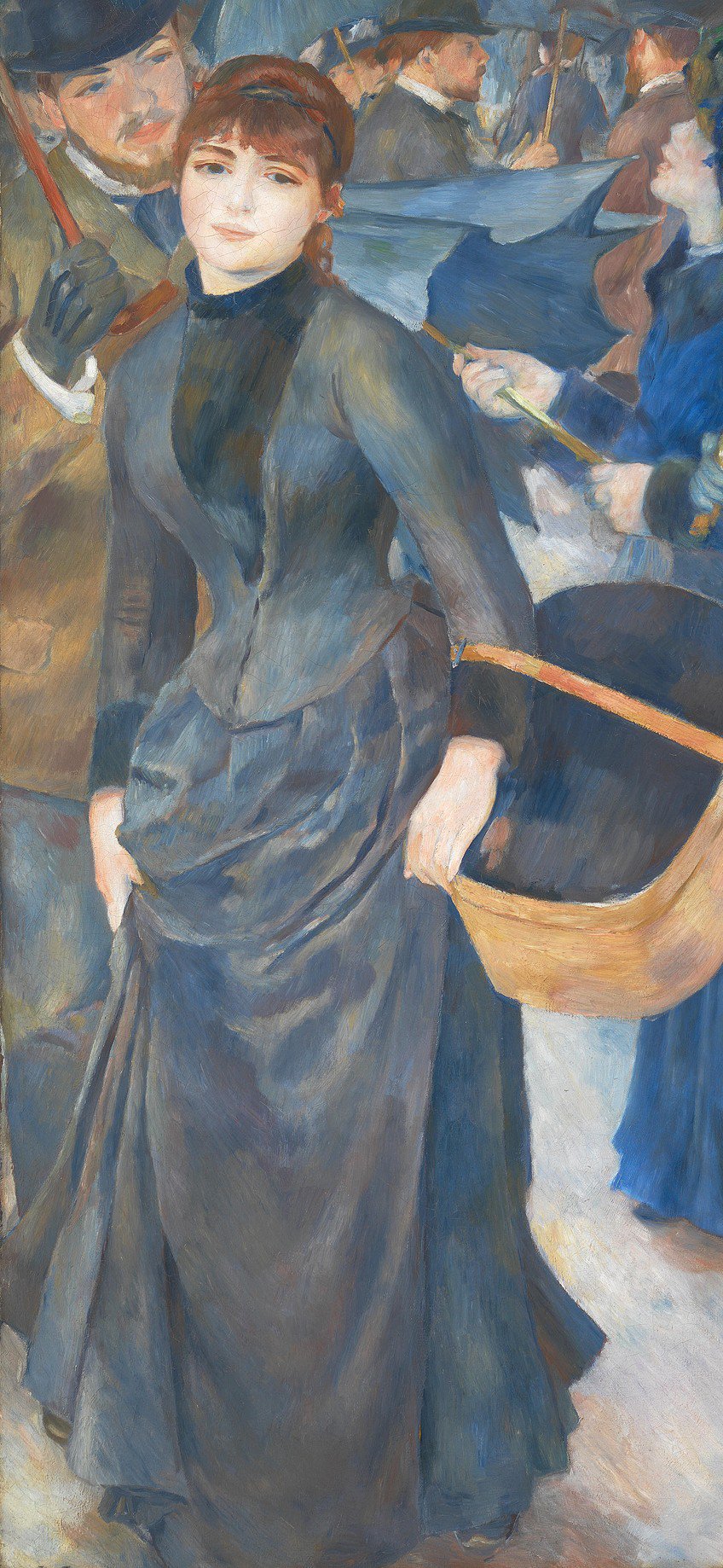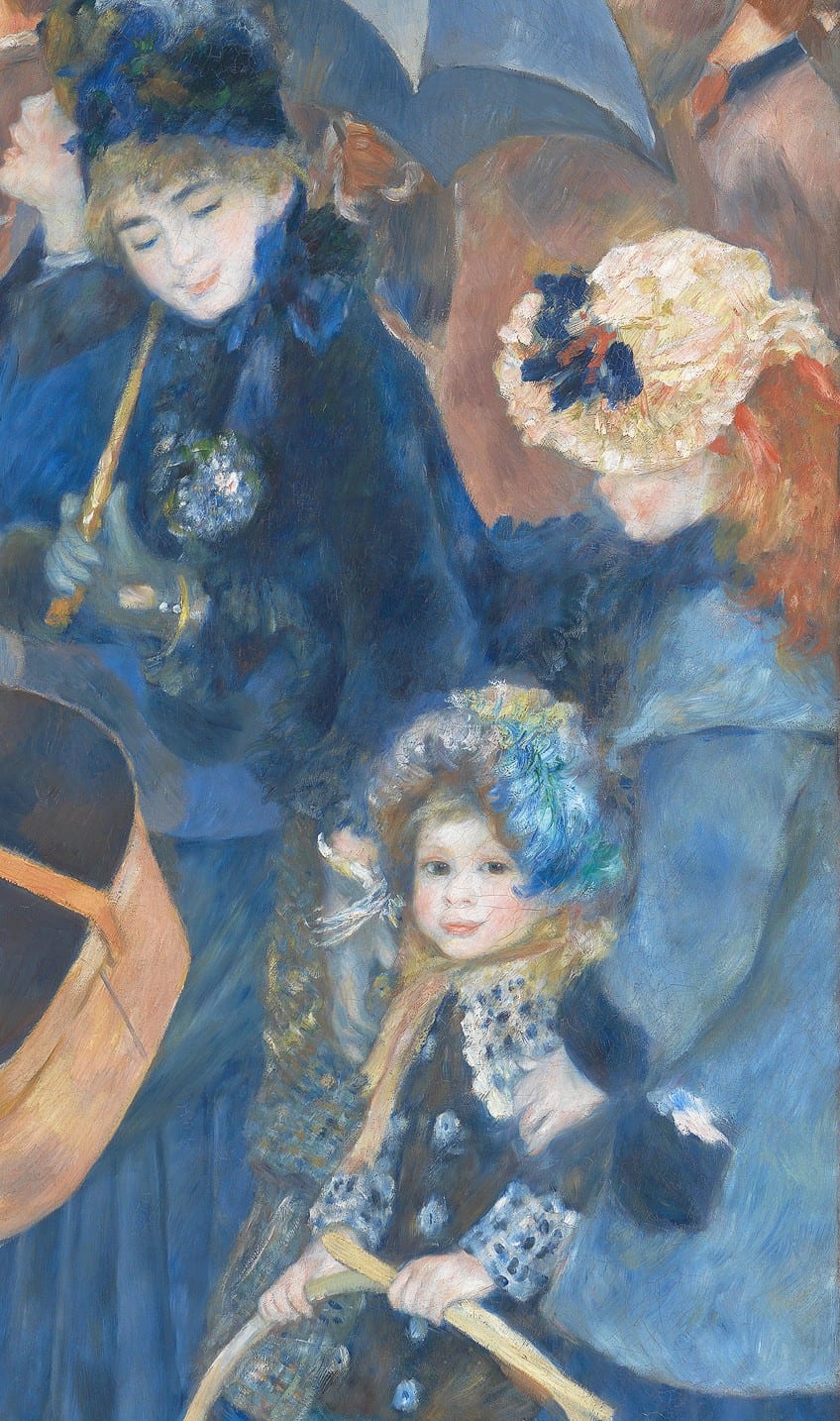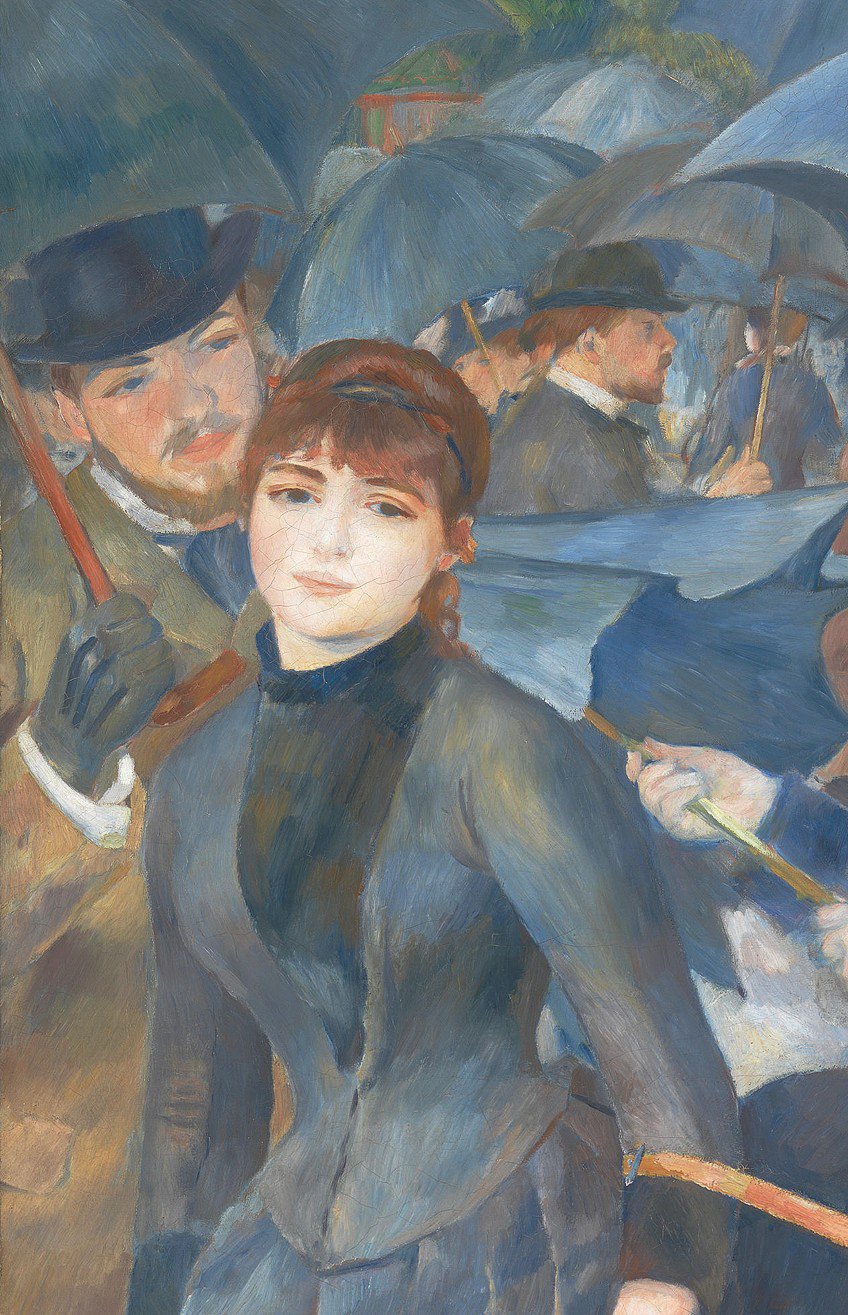“The Umbrellas” by Pierre-Auguste Renoir – A Quick Analysis
One of the most interesting aspects of The Umbrellas by Pierre-Auguste Renoir is that it was painted in two different time periods. The famous umbrella painting portrays a busy Parisian street full of people taking cover under their umbrellas. Renoir first started work on the painting in 1880, and then proceeded to rework and add elements five years later. Let us find out more about this famous artwork below, with our look at the umbrella painting analysis and history!
Contents
Understanding The Umbrellas by Pierre-Auguste Renoir
| Artist Name | Pierre-Auguste Renoir (1841 – 1919) |
| Date Completed | c. 1880 – 1886 |
| Medium | Oil on canvas |
| Dimensions | 180 x 114 |
| Current Location | The National Gallery, London, United Kingdom |
While all those present in the painting seem to be hidden under umbrellas due to the weather, we cannot see any actual rain in this famous umbrella painting. Perhaps it portrays a moment between downpours, as we can observe semi-gray skies in the background. Yet, the focus here is not on the weather, but rather on the umbrellas and the people beneath them. Before we dive into the umbrella painting analysis, let’s find out a little more about its artist.
An Introduction to Pierre-Auguste Renoir
| Artist Name | Pierre-Auguste Renoir |
| Nationality | French |
| Date of Birth | 25 February 1841 |
| Date of Death | 3 December 1919 |
| Place of Birth | Limoges, France |
Renoir was a significant figure in the Impressionist movement. In order to capture the movement and light of his figures and landscapes, he developed a style of broken brushstrokes and applied strong combinations of pure complementary colors. Following a number of rejections by Salon juries, he collaborated with Sisley, Monet, Pissarro, and many other painters to organize the first Impressionist show in April 1874. Renoir journeyed abroad in the 1880s, visiting Spain, Holland, Germany, England, and North Africa.
He enjoyed the paintings of Velázquez, Raphael, and Rubens, and the influence of the latter can be observed in his artwork.

After a trip to Italy in 1881, his style evolved into something more linear and traditional. Renoir was influenced by Édouard Manet and Camille Pissarro’s subject matter and style. His art is about pleasant experiences, with no real seriousness present in his subject matter. He was most known for his portraits, landscapes, and nudes. Now that we know a little more about the artist, let’s find out more about the famous umbrella painting.
The Umbrellas Painting History
Renoir started creating the work around 1880, using loose brush strokes with dark and brilliant tones that were characteristic of the Impressionist style. After abandoning Impressionism and looking for influence from the ancient art he saw in Italy, as well as the works of Cézanne and Ingres, he rebuilt elements of the painting in around 1886.
He focused on the main female character to the left of the canvas, employing a more classical linear technique and muted colors, and then added the background scenery and the umbrellas themselves.

X-ray photography revealed that the female figure’s clothes had previously been painted differently from how it appears in the final image. She originally wore a hat and her dress consisted of horizontal rows of frills with white lace cuffs, implying she was middle-class, however, the more basic clothing in the reworked artwork establishes her as a working-class woman.
The x-ray analysis, followed by the changing fashions, allows the various dates that the work was produced to be dated with acceptable accuracy.
The Umbrellas Painting Analysis
To the right of the painting, we can see a mother looking down at her daughters, who are dressed for the afternoon promenade in the fashion that was popular in 1881. She is standing in front of another woman in the center of the frame who seems to be raising her umbrella in anticipation of another downpour.
Renoir’s beloved Suzanne Valadon served as the model for the main female figure to the left of the painting, and she can be seen pulling up her skirt to avoid the mud on the road while carrying a hatbox. She does not have an umbrella like the others present.

A young bearded man appears to be approaching her, maybe to offer the young woman protection under his umbrella. While the other people seem unaware of the viewer, the woman to the left and one of the two girls stare out at us. The emphasis of a painting is usually in the center, yet here, many of the subjects are cut off by the frame, similar to a photograph. The painting’s composition seems natural, yet the angles of the umbrellas are thoughtfully organized to create geometric shapes, with rounded elements added by the primary figure’s bandbox and the hoop held by one of the girls.
Two Periods of Production
This piece was executed in two distinct styles: the first part, containing the individuals on the right, was most likely produced in 1881, while the later section, containing the foreground pair, was most likely produced in 1885. This prolonged execution phase is characteristic of Renoir’s paintings from the 1880s, yet the lack of a consistent style is rare.
The different clothing fashions depicted in the various characters give further evidence for the dating of these phases of production, as the artist always portrayed modern life as it was at that time.
The figures to the right of the painting are rendered in light, feathery brushstrokes, which are typical of Renoir’s early Impressionist technique, as are the young girl and woman’s beautiful smiles. The two figures on the canvas’ left are painted in a much bolder and more structured style that incorporates the planar technique of Cezanne. The influence of Cezanne’s “constructive strokes” is most visible in the rendering of the background trees.

This is regarded as the last of Renoir’s large-scale depictions of contemporary life. It proved difficult to sell because of the contrast in styles and fashions apparent in the painting, the latter of which was particularly obvious to the people of his time. Nonetheless, for whatever reason, he didn’t want to modify the earlier sections to produce a more coherent image and preferred to keep it as it was.
Analysis of the famous umbrella painting’s pigments at the National Gallery in London validated the assumption that it was produced in two distinct periods.
The outfit of the woman on the left has two layers: the lowest one includes cobalt blue mixed with red lake and zinc yellow, and the upper one contains cobalt blue mixed with red lake and zinc yellow. This is the same pigment blend that was used on the mother on the right as well as her daughters.

Both of these layers were originally painted during the initial 1881 phase. The upper layer of the figure on the right’s clothing, painted in the last phase in 1885, is a blend of ultramarine and other pigments with a much less intense bluish-gray color.
That wraps up our look at The Umbrellas by Pierre-Auguste Renoir. This famous umbrella painting is a significant example of a painter who was dissatisfied with his style, featuring a combination of Impressionism and classic linear brushwork. Renoir was also very meticulous about depicting fashion as it was at that period, so we not only observed several styles of painting, but also several styles of fashion. Even the type of clothing was changed, with e-rays revealing that the clothing was originally the type worn by members of the higher classes of society. Because the painting portrayed different styles and fashions, the artist found it rather difficult to sell the piece. Today, however, it is regarded among Renoir’s most notable works.
Frequently Asked Questions
What Was the Famous Umbrella Painting Called?
The famous umbrella painting is called The Umbrellas. It was painted by Pierre-Auguste Renoir in two distinct periods of time. The first part was painted in 1881, whereas the second part was painted in 1886. It features a Parisian scene of people carrying their umbrellas as they walk around a street.
What Is The Umbrellas by Pierre-Auguste Renoir Known For?
The interesting thing about this painting is that it was painted in two different time periods, and each period features a different art style. Renoir started the painting in the Impressionist style, but the second part was done in a more classical linear manner. Not only that, but the fashion of the clothing worn by the people in the painting differed depending on which period they were painted in. The woman on the left was painted in a slightly more contemporary style, whereas the people on the right wore clothing popular in 1881.
Jordan Anthony is a Cape Town-based film photographer, curator, and arts writer. She holds a Bachelor of Art in Fine Arts from the University of the Witwatersrand, Johannesburg, where she explored themes like healing, identity, dreams, and intuitive creation in her Contemporary art practice. Jordan has collaborated with various local art institutions, including the KZNSA Gallery in Durban, the Turbine Art Fair, and the Wits Art Museum. Her photography focuses on abstract color manipulations, portraiture, candid shots, and urban landscapes. She’s intrigued by philosophy, memory, and esotericism, drawing inspiration from Surrealism, Fluxus, and ancient civilizations, as well as childhood influences and found objects. Jordan is working for artfilemagazine since 2022 and writes blog posts about art history and photography.
Learn more about Jordan Anthony and about us.
Cite this Article
Jordan, Anthony, ““The Umbrellas” by Pierre-Auguste Renoir – A Quick Analysis.” artfilemagazine – Your Online Art Source. October 25, 2023. URL: https://artfilemagazine.com/the-umbrellas-by-pierre-auguste-renoir/
Anthony, J. (2023, 25 October). “The Umbrellas” by Pierre-Auguste Renoir – A Quick Analysis. artfilemagazine – Your Online Art Source. https://artfilemagazine.com/the-umbrellas-by-pierre-auguste-renoir/
Anthony, Jordan. ““The Umbrellas” by Pierre-Auguste Renoir – A Quick Analysis.” artfilemagazine – Your Online Art Source, October 25, 2023. https://artfilemagazine.com/the-umbrellas-by-pierre-auguste-renoir/.



